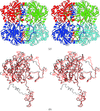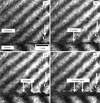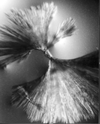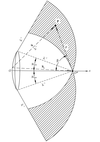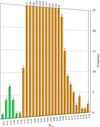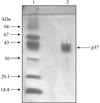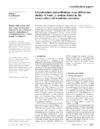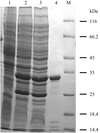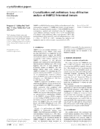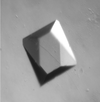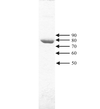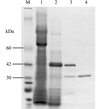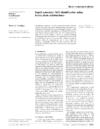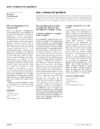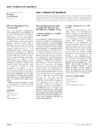issue contents
December 2002 issue

Cover illustration: View of several protein crystals in their plates or isolated. The proteins are produced from unknown ORFs of E. coli, within a structural genomics programme. The crystals were obtained with a nanodrop dispensing robot. The initial volume of the drops was 100 + 100 nl. Most crystals appeared between 4 and 48 h (p. 2109).
editorial
Free 

research papers
The crystal structure of the bacterial catalase from M. lysodeikticus has been refined at 0.88 Å using the gene-derived sequence, revealing the active site with unprecedented accuracy. In addition, the structures of the ferryl intermediate of the catalase (compound II) at 1.96 Å resolution and the catalase complex with NADPH at 1.83 Å resolution have been determined.
Studies of a number of Glu→Ala single and multiple mutants of RhoGDI show that such mutations may be generally useful to enhance protein crystallizability. One of the mutants yielded data to 1.2 Å resolution, showing that surface mutants can be used to dramatically improve the resolution of X-ray data.
PDB reference: RhoGDI, 1kmt, r1kmtsf
Structures of triosephosphate isomerase (TIM) from the malarial parasite P. falciparum (Pf) complexed to the substrate analogues 3-phosphoglycerate and glycerol-3-phosphate have been determined at 2.4 Å resolution. The catalytic loop of TIM adopts a novel `loop-open' conformation in these complexes. These structures provide insight into the design of inhibitors specific for the malarial enzyme.
Two 1.8 Å resolution crystal structures of the Ser205 mutant plasmepsin II from P. falciparum in complex with two Phe–Leu core inhibitors that incorporate tetrahedral transition-state mimetic hydroxypropylamine are described.
The transition-state complex of this 42 kDa homologue of creatine kinase has been refined at 1.2 Å resolution. It indicates that precise positioning of substrates and restriction of the active-site motion are important components in catalysis.
PDB reference: AK-TSAC, 1m15, r1m15sf
The crystallographic structure of a circularly permuted form of yeast PGK has been determined to a resolution of 2.3 Å. The overall fold of the protein is very similar to that of the wild-type protein, directly demonstrating that the continuity of a folding unit is not relevant to the folding process of the whole protein.
PDB reference: circularly permuted phosphoglycerate kinase, 1fw8, r1fw8sf
The diffusivity of lysozyme molecules was deduced to decrease under a magnetic field, based on the discovery of magnetic damping of the dissolution process using a Mach–Zehnder interferometer. In the same experiment, a redistribution of the concentration before crystal growth was also found.
A new structure of carbonmonoxyhemoglobin solved at 2.16 Å is reported. The new structure, obtained using a lower pH, shows significant strain at the α1β2 (α2β1) interface, suggests initiation of the R to T allosteric transition.
PDB reference: COHbA, 1ljw, r1ljwsf
The first high-resolution crystal structure for liganded hemoglobin C, a mutant hemoglobin that forms crystals in red blood cells of individuals with CC and SC diseases, was obtained from a COHbC crystal grown in concentrated potassium phosphate buffer. The dynamic structure of the βEK6 side chain could potentially support a number of specific polar interactions that may contribute to enhanced nucleation kinetics for HbC relative to HbA.
PDB reference: HbC(CO), 1k1k, r1k1ksf
A new computational procedure called CAPRA is described that predicts coordinates of Cα atoms in density maps and outputs chains of Cα atoms representing the backbone of the protein.
The structure of a cocaine hydrolytic antibody has been determined from a pseudomerohedrally twinned crystal. The lattice is primitive monoclinic with higher apparent primitive orthorhombic symmetry.
Glycerol displaces water molecules bound to thaumatin.
A simultaneous analysis of several rotation functions allows the model orientation to be found in situations when the standard search fails. An automated procedure has been developed to apply such an analysis routinely.
The dependence of protein solubility on ionic strength was measured for the bacterial reaction center in different detergents and amphiphiles. The detergent and amphiphile combinations that yielded the highest solubility of the protein are correlated with those that yield protein crystals.
Open  access
access
 access
accessStatistical density modification can make use of NCS in a crystal and can include estimates of the deviations from perfect NCS.
The convergent-beam method of data collection for macromolecular crystals is described.
The structure of E. coli argininosuccinate synthetase (EAS) has been determined using S-SAD, Se-SAD and S/Se-SIRAS data measured with Cu Kα radiation.
Insights are gained into high-throughput target selection, cloning, expression and crystallization of human genomic proteins. For example, there was a marked difference seen bewteen the ease of expression of proteins of molecular weight (MW) < 25 kDa (93% success), compared with proteins > 25 kDa MW, which were less easy to express (61% success).
structural genomics papers
In the context of a medium-scale structural genomics program, a crystallization approach was based on a two-step procedure: a large screening step employing robotics, followed by manual or automated optimization of the crystallization conditions. A nanodrop dispensing robot (50–200 nl) proved to be useful for obtaining diffracting crystals while using small amounts of protein. In 10 months, 25 proteins were subjectred to crystallization, 13 yielded crystals among which ten led to usuable data sets and five to structures.
This study demonstrates that phases obtained at low resolution (>3.0 Å) from crystals of SeMet-labeled protein can be successfully used for automated structure determination.
PDB reference: acetate CoA-transferase α-subunit, 1k6d, r1k6dsf
crystallization papers
Contortrostatin, a small homodimeric protein (64 residues per chain) from southern copperhead snake venom, has been crystallized successfully. Crystals of the title compound, which is a member of the disintegrin family of proteins, diffract up to a maximum resolution of 1.7 Å.
The first crystallographic study of an α-amylase from an organism that is both thermophilic and halophilic, at 1.89 Å resolution.
The Ndt80 protein is a transcriptional activator that plays a key role in the progression of the meiotic divisions in the yeast Saccharomyces cerevisiae. Crystals of the DNA-binding domain of Ndt80 in two distinct lattices have been obtained, for which diffraction data extend to 2.3 Å resolution.
This report details the production, purification, crystallization and preliminary diffraction analysis of a T-cell receptor.
The recombinant carbohydrate-binding domain of the cell-surface lectin flocculin from brewer's yeast has been identified, purified and crystallized.
The B. subtilis ytxM gene product has been crystallized and a MAD data set has been collected to 2.0 Å resolution.
P37, an outer-membrane bacterial protein from Mycoplasma hyorhinis whose presence on the surface of many tumor cells correlates highly with increased neoplastic invasivity and metastasis, has been overexpressed in Escherichia coli, purified by affinity chromatography and crystallized.
Acetohydroxy acid isomeroreductase from P. aeruginosa was crystallized. X-ray data have been collected to 2.0 Å resolution using synchrotron radiation (P213, a = b = c = 184.38 Å).
The crystallization and preliminary characterization of the MalFGK2 transport complex from T. litoralis is presented.
Overexpression, purification and crystallization of P. aeruginosa L-arginine deiminase allowed collection of a complete MAD data set to 3.2 Å resolution.
Diffraction-quality Se-met crystals of S. aureus PDF were prepared that belong to space group C2221 with unit-ell parameters of a = 94.1 b = 121.9 c = 47.6 Å. Crystals were also prepared with three PDF inhibitors: thiorphan, actinonin and PNU-172550.
N-utilization factor G (NusG) from A. aeolicus has been overexpressed, purified and crystallized. The crystals diffract to 2.45 Å resolution.
2-Methylisocitrate lyase from S. typhimurium IFO 12529 has been cloned, overexpressed and crystallized. The crystal belongs to space group P212121, with unit-cell parameters a = 63.600, b = 100.670, c = 204.745 Å. A complete data set to 2.5 Å resolution has been collected.
Extremely thermostable isocitrate dehydrogenases from A. pernix and T. maritima were crystallized and X-ray diffraction data were collected to 2.6 and 2.8 Å, respectively. The crystallization and preliminary crystallographic analysis are described for both enzymes.
A new PR-10 family protein SPE16 with ribonuclease activity was purified from the seeds of P. erosus as a constitutive protein and has been crystallized.
The N-terminal (amino acids 1–140) domain of human FKBP52 has been crystallized. The crystals belong to space group P21 with unit-cell parameters a = 27.8, b = 58.4, c = 70.9 Å, β = 98.3° and diffract to 2.4 Å resolution limit.
The PTB domain of human dok-5 protein has been crystallized as well as a selenomethionmine-substituted protein for MAD phasing determination. The crystals belong to space group P3221 (a = b = 75.9, c = 108.0 Å) and diffract up to 2.3 Å resolution using synchrotron radiation.
Naphthalene dioxygenase from Rhodococcus has been crystallized in space group P212121. The crystals diffract to 2.3 Å resolution.
A thermostable D-hydantoinase from mesophilic Bacillus sp. AR9 was crystallized and diffracted to 2.3 Å resolution having unit-cell parameters a = b = 129.55, c = 102.8 Å, α = β = 90, γ = 120°.
The lysyl oxidase isolated from the yeast P. pastoris has been crystallized and synchrotron data have been recorded to a resolution of 1.65 Å.
Creatinine amidohydrolase (creatininase; EC 3.5.2.10) from P. putida has been overexpressed in E. coli and crystallized by the hanging-drop method.
Crystals of B. cepacia cholesterol oxidase, a 3β-hydroxysteroid oxidase containing covalently bound FAD, were obtained by the hanging-drop method using polyethylene glycol as a precipitant. The crystals diffract to beyond 2.0 Å and belong to space group P3121, with approximate unit-cell parameters a = b = 119.6, c = 101.1 Å and one subunit in the asymmetric unit.
Crystals of the catalase–peroxidase from B. pseudomallei diffract to beyond 1.8 Å.
A human papain-family cysteine protease has been expressed in P. pastoris, purified by conventional chromatography and crystallized.
An ORF from the E. coli K12 genome with 56% sequence identity to 2,4-dihydroxy-hept-2-ene-1,7-dioic acid (HHED) aldolase has been cloned, expressed and purified. Crystals obtained from the purified recombinant enzyme, belonging to space group C2221, diffracted to a resolution of 1.78 Å.
A long solvent-exposed coiled coil in the large subunit (CBP80) of the heterodimeric nuclear cap-binding complex (CBC) has been truncated to permit crystallization of CBC with the cap analogue m7GpppG in two crystal forms diffracting to 2.15 and 2.3 Å resolution.
The structure of the thermolysin (TLN) crystallized in the presence of SCN− suggests explanations for the solubility increase of TLN and for the inhibitory effect of high SCN− concentrations on the TLN activity.
PDB reference: thermolysin, 1gxw, r1gxwsf
short communications
The complex of the H. insolens cellobiohydrolase Cel6A in complex with a thiooligosaccharide substrate analogue has been determined at 1.9 Å resolution.
PDB reference: D416A Cel6A complex, 1gz1, r1gz1sf
Crystallization analyasis of twinned diffraction data of d(ApTpApTpApT) in a hexagonal packing.
The structure of inactive pyruvate formate-lyase in complex with a natural substrate, pyruvate, has been solved at 2.7 Å resolution.
PDB reference: pyruvate formate lyase–pyruvate complex, 1mzo, r1mzosf
Open  access
access
 access
accessA rapid algorithm for identifying NCS in heavy-atom sites is described.
new commercial products
Free 

Free 



 journal menu
journal menu












